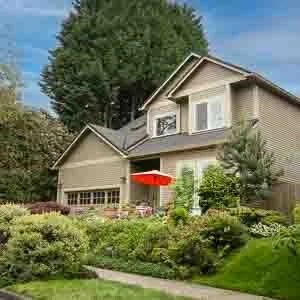
Find Your Coveted Portland
Colonial Home
Timeless Elegance
with Lasting Appeal
Enduring Beauty
The Colonial’s Lasting Influence in Portland
Colonial Revival homes in the Portland metro area are a perfect blend of classic symmetry and enduring charm, drawing inspiration from early American architecture. Rooted in the homes built by Dutch, French, Spanish, and English settlers, the style reflects a refined yet practical approach to home design. While traditional Colonial homes first emerged on the East Coast, the Colonial Revival movement brought this elegant aesthetic westward, making it a beloved part of Portland’s architectural landscape. Today, you’ll find these stately homes throughout Southwest, Northeast, and Southeast Portland, as well as in historic pockets of nearby suburbs.
This style evolved over two major waves. The first Colonial Revival era (1880–1945) featured homes with ornate detailing, durable materials, and handcrafted finishes, reflecting a commitment to craftsmanship. After World War II, the Neo-Colonial era (1945 onward) simplified the design, incorporating aluminum or vinyl siding and fewer decorative elements. Despite these changes, the hallmarks of Colonial homes—symmetry, grand entryways, and multi-pane windows—remained intact, preserving their historic elegance even in more streamlined versions.
In Portland, you’ll find a range of Colonial-inspired designs, including Georgian, Dutch, French, and Spanish Colonial styles, as well as the Colonial Cape Cod Revival, which offers a more compact version of the classic form. Many of these homes are concentrated in Southwest and Northeast Portland, where larger, historic homes were built on scenic lots, while Southeast Portland features a mix of Colonial and smaller Cape Cod styles. Thanks to their rectangular footprint and solid construction, these homes are ideal for expansions, making them highly adaptable for modern living. Whether carefully preserved or thoughtfully updated, Colonial homes in Portland continue to offer timeless curb appeal and a connection to architectural history.
Explore Portland’s Best Neighborhoods
for Colonial-Style Homes
Eastmoreland
Strolling through Eastmoreland feels like stepping back in time. The neighborhood boasts a harmonious blend of Colonial-style residences, each exuding classic charm. Tree-lined streets and manicured lawns complement these stately homes, making Eastmoreland a sought-after enclave for architectural enthusiasts.
Irvington
Irvington's rich history is reflected in its well-preserved Colonial Revival homes. The neighborhood's commitment to maintaining its architectural heritage ensures that these elegant structures continue to captivate residents and visitors alike.
Arlington Heights
Nestled in the West Hills, Arlington Heights boasts a rich architectural tapestry, including notable Colonial-style homes. The neighborhood's elevated terrain offers scenic vistas, and its proximity to Washington Park enhances its allure.
Laurelhurst
Laurelhurst seamlessly blends various architectural styles, with Colonial homes adding to its diverse aesthetic. Wide boulevards and lush parks enhance the neighborhood's appeal, making it a picturesque setting for these classic homes





What Makes a Colonial Home Unique?
Colonial homes in Portland embody timeless symmetry, classic proportions, and stately entrances, standing as architectural landmarks in the city's historic districts. Built between the late 19th and early 20th centuries, these homes reflect East Coast influences adapted to the Pacific Northwest, with styles ranging from traditional side-gabled Colonials to gambrel-roofed Dutch Colonials. Their grand facades, spacious interiors, and elegant details continue to offer a perfect balance of formality and warmth.
Colonial Characteristics
Commanding Presence – With two to three stories, Colonial homes rise tall, emphasizing their stately, symmetrical facades and creating a sense of permanence and grandeur.
Perfectly Balanced Design – These homes maintain a rectangular or square footprint, with a central front door flanked by evenly spaced windows, reinforcing their elegant symmetry.
Welcoming Entrances – A decorative crown or pediment over the front door, often supported by columns or pilasters, creates an impressive focal point, sometimes leading to a covered entry or small portico.
Time-Honored Windows – Multi-pane, double-hung windows—often with six, eight, or even twelve panes above a single pane below—bring in natural light, sometimes accented by shutters for added charm.
Side Porches & Sunrooms – While formal in design, many Colonial homes in Portland feature side porches or sunrooms, providing a cozy retreat while maintaining the home’s classic lines.
Classic Roofing – A medium-pitched, side-gabled roof with narrow eaves defines the Colonial silhouette, providing both function and stately curb appeal.
Brick or Clapboard Exteriors – While narrow clapboard siding is common, some Colonial homes are built with brick facades, adding a level of durability and distinction.
Grand Central Chimneys – A massive brick chimney serves as both a visual anchor and a practical heat source, historically designed to warm multiple rooms at once.
Graceful Interiors – The front door typically opens to a grand staircase and formal entryway, setting the tone for the home’s gracious layout and refined architectural details.
Dutch Colonial Characteristics
Iconic Gambrel Roof – The gently curved gambrel roof is the hallmark of Dutch Colonial homes, allowing for extra space on the upper level while maintaining the home’s distinctive shape.
Charming Dormers – One or more dormers punctuate the upper level, adding light, ventilation, and extra headroom in the second story.
Smaller Casement Windows – Unlike their more formal Colonial counterparts, Dutch Colonials sometimes feature small casement windows rather than large multi-pane designs.
The Birth of the American Dream Home
Colonial homes became the blueprint for traditional American houses, influencing everything from post-war suburban developments to modern-day new builds that still mimic their classic proportions.
“Colonial-style homes gained popularity in Portland between the late 19th and early 20th centuries, bringing East Coast sophistication to the Pacific Northwest. While many were built during the Colonial Revival boom of the 1920s and 1930s, their graceful symmetry, grand entrances, and timeless charm continue to make them some of the city’s most admired homes today.”
Colonial Style Homes for Sale in Portland, Oregon
.
Your Search, Your Way
Experience the Beauty of Pacific Northwest Architecture
At Campbell Salgado Real Estate Group, we have a deep appreciation for the classic beauty of Colonial Revival homes. We’re passionate about helping people buy and sell these timeless properties in Portland, Oregon.
With our extensive market knowledge and love for Colonial architecture, we take pride in connecting each client with their perfect home. Whether you’re looking for a grand Colonial with stately columns or a cozy Colonial with charming details, we’re here to support you every step of the way.
Let us make your home buying or selling experience seamless and enjoyable. Contact us today at 503-951-8547 to begin your journey!
Kim Campbell & Francisco Salgado
















